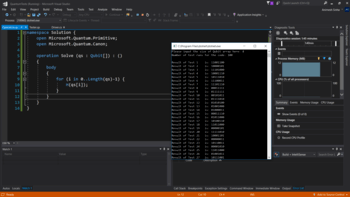Q Sharp
| Paradigm | multi-paradigm: quantum, functional, imperative |
|---|---|
| Designed by | Microsoft Research (quantum architectures and computation group; QuArC) |
| Developer | Microsoft |
| First appeared | December 11th, 2017 |
| Typing discipline | static, strong |
| Platform | Common Language Infrastructure |
| Filename extensions | .qs |
| Website | Microsoft Quantum (GitHub) |
| Influenced by | |
| C#, F# | |
Q# (pronounced as Q sharp) is a domain-specific programming language used for expressing quantum algorithms.[1] It was initially released to the public by Microsoft as part of the Quantum Development Kit.[2]
History
During a Microsoft Ignite Keynote on September 26, 2017, Microsoft announced that they were going to release a new programming language geared specifically towards quantum computers.[3] On December 11, 2017, Microsoft released Q# as a part of the Quantum Development Kit.[2]
Usage
Q# is available as a separately downloaded extension for Visual Studio,[4] but it can also be run as an independent tool from the Command line and/or Visual Studio Code. The Quantum Development Kit ships with a quantum simulator which is capable of running Q#.
In order to invoke the quantum simulator, another .NET programming language, usually C#, is used, which provides the (classical) input data for the simulator and reads the (classical) output data from the simulator.
Features
A primary feature of Q# is the ability to create and use qubits for algorithms. As a consequence, some of the most prominent features of Q# are the ability to entangle and introduce superpositioning to qubits via Controlled NOT gates and Hadamard gates, respectively, as well as Toffoli Gates, Pauli X, Y, Z Gate, and many more which are used for a variety of operations; see the list at the article on quantum logic gates.
The hardware stack that will eventually come together with Q# is expected to implement Qubits as topological qubits. The quantum simulator that is shipped with the Quantum Development Kit today is capable of processing up to 32 qubits on a user machine and up to 40 qubits on Azure.
Documentation and Resources

Currently, the resources available for Q# are scarce, but the official documentation is published: Microsoft Developer Network: Q#. Microsoft Quantum Github repository is also a large collection of sample programs implementing a variety of Quantum algorithms and their tests.
Microsoft has also hosted a Quantum Coding contest on Codeforces here: http://codeforces.com/msqs2018, and also provided related material to help answer the questions in the blog posts, plus the detailed solutions in the tutorials.
Microsoft hosts a set of learning exercises to help learn Q# on github: https://github.com/Microsoft/QuantumKatas with links to resources, and answers to the problems.
Syntax
Q# is syntactically related to both C# and F# yet also has some significant differences.
Similarities with C#
- Uses
namespacefor code isolation - All statements end with a
; - Curly braces are used for statements of scope
- Single line comments are done using
// - Variable data types such as
intdoublestringandboolremain the same[1] - Qubits are allocated and disposed inside a
usingblock. - Lambda functions using the
=>operator. - Results are returned using the
returnkeyword.
Similarities with F#
- Variables are declared using either
letormutable[1] - First-order functions
- Modules, which are imported using the
openkeyword - The datatype is declared after the variable name
- The range operator
.. for … inloops- Every operation/function has a return value, rather than
void. Instead ofvoid, an empty Tuple()is returned. - Definition of record datatypes (using the
newtypekeyword, instead oftype).
Differences
References
- 1 2 3 QuantumWriter. "Intent and product brand in a unique string of 43-59 chars including spaces". docs.microsoft.com. Retrieved 2017-12-11.
- 1 2 "Announcing the Microsoft Quantum Development Kit". Retrieved 2017-12-11.
- ↑ "Microsoft announces quantum computing programming language". Retrieved 2017-12-14.
- ↑ QuantumWriter. "Setting up the Q# development environment". docs.microsoft.com. Retrieved 2017-12-14.
